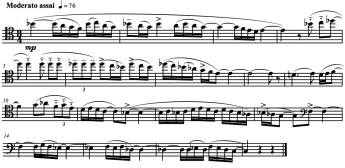Why Musicians Make Good Analysts
- by 7wData

I recently read Taming the Big data Tidal Wave by Bill Franks of Teradata and in the book (which is going on my recommended reading list) he has a section about the ideal analyst. While I am admittedly very biased on this one, Mr. Franks makes a very good point that in many instances the best analysts have a musical or other creative ability in addition to math and computer science skills. In my experience, the best data scientists that I’ve worked with all have had some creative side to them–be it music, art or whatever. Thus, here is my case why play an instrument is perhaps some of the best preparation to think like an analyst.
This may seem out of place, but consider what happens when a musician receives a piece of music to play for the first time. Most musicians will read through the sheet music and either sing through it via solfege, or otherwise mentally convert the written notes on the page into a mental version of the music. Every musician has their own method, but basically, they’ll transform the notes on the page into a mental version of the music. In many ways, this closely parallels the Extract-Transform-Load (ETL) process that is the first step in any data analytic project. The data–in this case the sheet music–is not in a form that can be readily used and so it must be loaded modified and transformed into a usable form. Often, especially for orchestral musicians, you have to transpose parts, or convert them from one clef to another or some other steps to convert the sheet music into a playable part. After a while, you get really good at this to the point that it really becomes second nature. In any event, I see this same quality in top notch data scientists. They can look at data, make some mental transformations and really just know what kind of value they can get from that data. I’m not suggesting that they can foresee the results, but they can come up with the plan from seeing the data.
A large part of playing any kind of music is understanding the fundamental structures inherent in most all western music and understanding where your individual part fits in the structure. A milestone in my playing occurred when I realized that almost all tonal music is made of two basic patterns: scales and arpeggios. Therefore, if you can identify these patterns in passages and can play them on your instrument, you can play almost anything quickly and easily. On top of that musicians also have to identify harmonic patterns, rhythmic patterns, and melodic patterns in order to understand the music and ultimately perform it well. So too for data analysts. Data scientists so too must be able to identify patterns in data that can be used to extrapolate future conclusions. I find that the pattern recognition ability has helped me a lot when it comes to writing regular expressions. I’m often able to formulate them very rapidly in my mind and then just use a tool like regexpal to test them.
Playing in a group, particularly a small group, is also a very analytic activity. Allow me to explain from the perspective of a trombonist playing in a brass quintet. Let’s say that in your part, you have a long note that is a D. Unlike a piano where you just press down the correct key, on a wind instrument, you have to use the correct amount of air, lip tension etc in order to just produce the correct sound.
[Social9_Share class=”s9-widget-wrapper”]
Upcoming Events
Evolving Your Data Architecture for Trustworthy Generative AI
18 April 2024
5 PM CET – 6 PM CET
Read MoreShift Difficult Problems Left with Graph Analysis on Streaming Data
29 April 2024
12 PM ET – 1 PM ET
Read More




